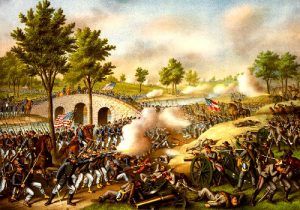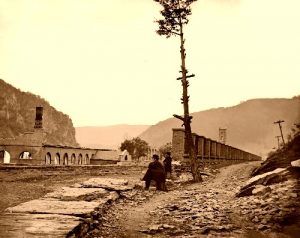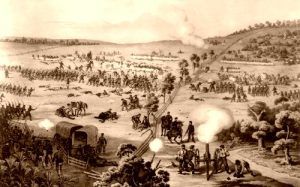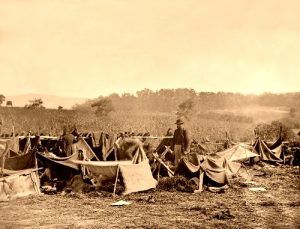Sometimes referred to as the Antietam Campaign, this series of four battles took place in September 1862 in West Virginia and Maryland. Considered one of the major turning points in the war, Confederate General Robert E. Lee’s goal was to reach the major Northern states of Maryland and Pennsylvania to threaten the cities of Washington and Baltimore, supply his army from the untouched farms, relieve the habitual fighting in Virginia, and hopefully make such an impact that the end of the war might be negotiated.
Lee divided his army into five parts, with General “Stonewall” Jackson taking three of them to attack Harpers Ferry to control the Shenandoah Valley.
General James Longstreet would lead the fourth part to Hagerstown to guard against a rumored movement of Union troops from Pennsylvania, and the fifth and final part, under the command of General Daniel Harvey Hill, was to guard the reserve artillery and wagon train at Boonsboro, Maryland, as well as watching for escaping Federals from Harpers Ferry.
On September 4, 1862, the Army of Northern Virginia crossed the Potomac River. It began the Maryland Campaign, which would be repulsed by Major General George B. McClellan and the Army of the Potomac, who intercepted General Robert E. Lee and his Army of Northern Virginia, attacking them near Sharpsburg, Maryland. The resulting Battle of Antietam was the bloodiest single-day battle in American History.
The Maryland Campaign included the following battles:
Maryland Campaign (September 1862)
- Harpers Ferry (September 12-15, 1862, West Virginia)
- South Mountain (September 14, 1862, Maryland)
- Antietam (September 16-18, 1862, Maryland)
- Shepherdstown (September 19-20, 1862, West Virginia)
Harpers Ferry (September 12-15, 1862) – In Lee’s first invasion of the North, General Robert E. Lee planned first to attack Harpers Ferry to control the Shenandoah Valley, capture its supplies, and secure his own supply line back to Virginia. He divided his army into four columns, three converging upon and attacking Harpers Ferry. On September 15, Confederate artillery was placed on the heights overlooking the town, which was virtually indefensible, dominated on all sides by higher ground, and not properly fortified.
As the Confederates bombarded the garrison from all sides and were preparing an infantry assault when Colonel Dixon S. Miles surrendered the garrison of more than 12,000 men.
It would be his last military action, as Miles, himself, was mortally wounded by a last discharge of firearms from a battery on Loudoun Heights.
Confederate Major General “Stonewall” Jackson took possession of Harpers Ferry and led most of his soldiers to join Lee at Sharpsburg. Major General A.P. Hill’s division was left to complete the occupation of the town.
After paroling the prisoners at Harpers Ferry, Hill’s division joined Lee, just in time to save Lee’s army from near defeat at Sharpsburg. Less than 100 men were killed in the battle of Harpers Ferry.
Additional Information:
Harpers Ferry National Historic Park
P.O. Box 65
Harpers Ferry, West Virginia 25425
304-535-6029
South Mountain (September 14, 1862) – Also called the Battle of Crampton’s, Turner’s, and Fox’s Gaps, this skirmish occurred in Frederick and Washington Counties, Maryland. While most of General Robert E. Lee’s Army was attacking Harpers Ferry, the rest marched on to Maryland, with Major General George B. McClellan hotly in pursuit. Following them to Frederick, Maryland, McClellan advanced on them at South Mountain, a natural formation that separates the Shenandoah and Cumberland Valleys from the eastern part of Maryland. Several battles were fought on September 14 over possession of the South Mountain passes: Crampton’s, Turner’s, and Fox’s Gaps.
By dusk, the Confederate defenders were driven back, suffering severe casualties, and McClellan was in a position to destroy Lee’s army before it could re-concentrate.
However, McClellan’s limited activity the next day gave Lee time to unite his scattered divisions at Sharpsburg. In the South Mountain Battle, an estimated 4,500 casualties were suffered, including Union General Jesse Reno and Confederate General Samuel Garland, Jr., who were killed.
Additional Information:
Appalachian National Scenic Trail
P.O. Box 50
Harpers Ferry, West Virginia 25425
304-535-6278
Antietam (September 16-18, 1862) – Also referred to as the Battle of Sharpsburg, Major General George B. McClellan confronted Lee’s Army of Northern Virginia at Sharpsburg, Maryland, west of Antietam Creek on September 16, 1862. At dawn the next day, Major General Joseph Hooker’s I Corps mounted a powerful assault on Lee’s left flank that began the single bloodiest day in American military history. Read more in our story, Battle of Antietam, Maryland – Bloodiest 1-Day Battle in American History.
Additional Information:
Antietam National Battlefield
P.O. Box 158
Sharpsburg, Maryland 21782
301-432-5124
Shepherdstown (September 19-20, 1862) – Also referred to as the Battle of Boteler’s Ford, this encounter occurred in Jefferson County, West Virginia, as the Confederate forces retreated southward. On September 19, a detachment of Union Major General Fitz John Porter’s V Corps pushed across the river at Boteler’s Ford, attacked the Confederate rearguard commanded by Brigadier General William Pendleton, and captured four guns. Early on the 20th, Porter pushed elements of two divisions across the Potomac to establish a bridgehead. Confederate Major General A.P. Hill’s division counterattacked while many of the Federals were crossing and nearly annihilated the 118th Pennsylvania (the “Corn Exchange” Regiment), inflicting 269 casualties. This rearguard action discouraged Federal pursuit. On November 7, President Abraham Lincoln relieved McClellan of command because he failed to follow up on Lee’s retreating army. Major General Ambrose E. Burnside rose to command the Union army. The end result of the battle was 625 casualties.
Compiled and edited by Kathy Alexander/Legends of America, updated March 2024.
See our Civil War Photo Galleries HERE
Also See:




